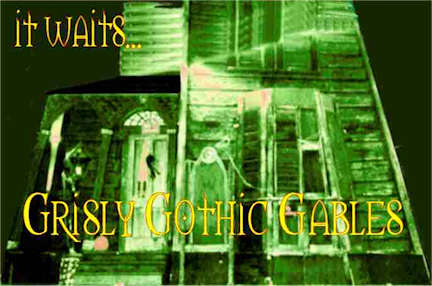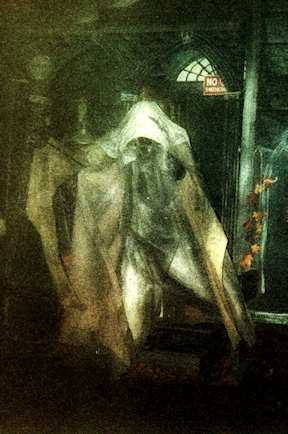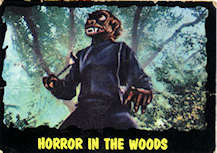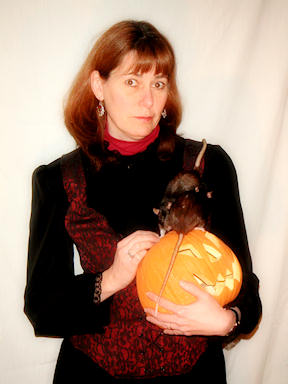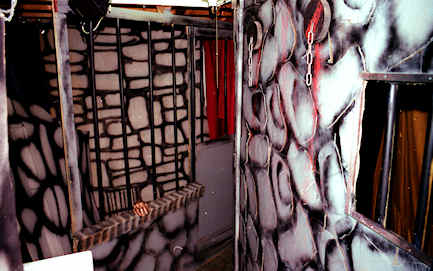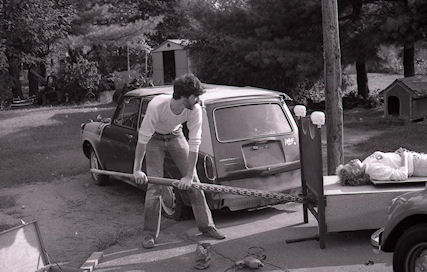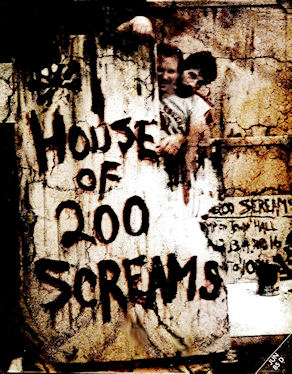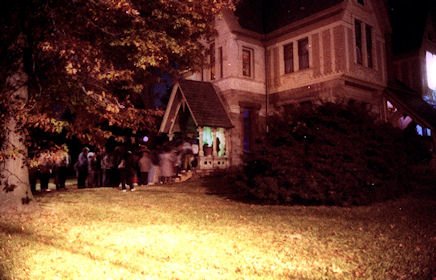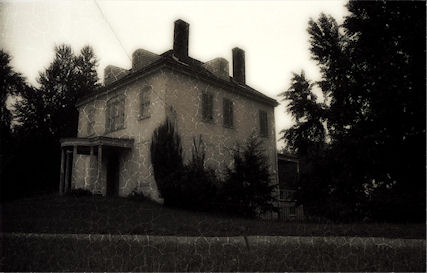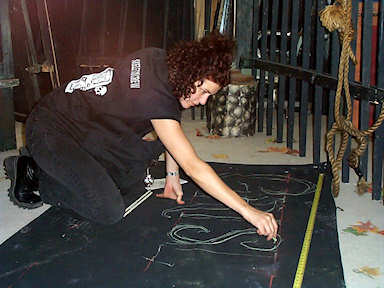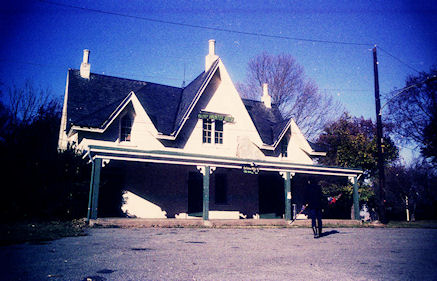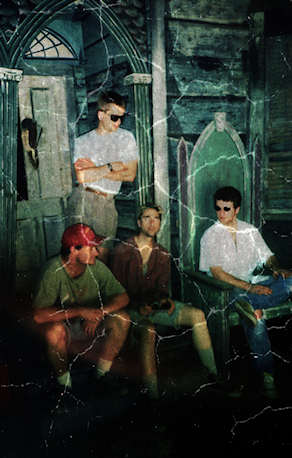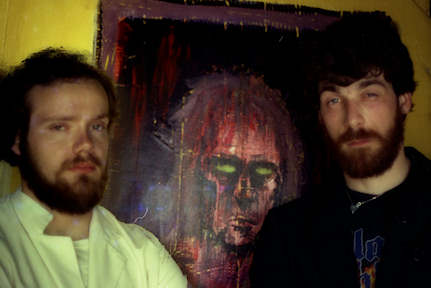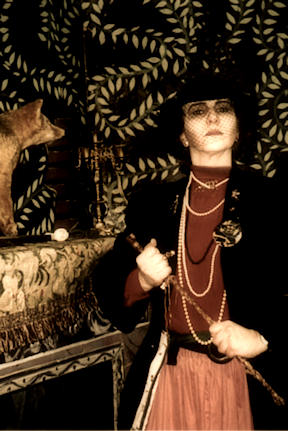The Haunting of Allan Erush
The Haunting of Allan Erush
by Dusti Lewars Poole
|
The Skeleton Crew They come together in early September to build, paint, write, act,and run Grisly Gothic Gables. Skill levels vary from expert set designers to those who are happiest painting walls black or helping load and unload the moving day trucks. Their paths rarely cross outside of the haunting season; but while working on Grisly, they almost seem to share a brain. Most of the time, they work as volunteers. All of them have invested their hearts and souls into this theatrical Philadelphia haunt. Meet the Skeleton Crew. There are a lot of theories on how to run a successful dark attraction; multiple-elements, a midway to attract the kids, corporate s ponsorships, and must-have animatronics. All of these ideas work to various degrees, but in the haunted city where Edgar Allan Poe walked the streets at night, and where parks were built over massive graveyards, the longest-running haunted house in Philadelphia stands alone without the use of pneumatics, carnivals, or flashy promotion deals. Welcome to a classic old-world style of Haunted Attraction. Welcome to Grisly Gothic Gables.
When telling the tale of Grisly Gothic Gables there are several recurring themes. One is water. My first memory of Grisly Gothic Gables is water, and lots of it. I stood in line for over an hour in front of Rockland Mansion, an historic home owned by the parks department and that October’s home of Grisly Gothic Gables.
In the downpour, half-expecting an ark to float by. Instead, an eight-foot Grim Reaper glided down the hill leading to the haunt trying to distract the sodden crowd. This menacing figure terrorized adults and children alike, who took refuge behind their dates and parents or inside of their parked cars. I later find out that this tall dark creature was none other than the owner and creator of Grisly, Allan Erush, know to his friends as “Bonedaddy.”
Roots Run Deep Allan George Erush was born April 18, 1957 in Northampton, Massachusetts.(His family actually lived in Easthampton, but the town was too small to have its own hospital.) The second child of four, he was fascinated early on by scary visuals and sounds, and at the age of 7, there were three things in particular that sparked his interest in the macabre. The first was a second-hand issue of a Monster Magazine, which Allan had traded for from one of the older boys in his neighborhood. Though its pages were dog-eared and its cover completely gone, the subjects covered therein - vampires and werewolves - intrigued him. In the early 60’s, Allan’s Dad built and painted an Aurora model kit of Dracula for Allan. (Both of which Allan cherishes to this day.) Third was the television s how Outer Limits."I remember sitting in front of the TV just watching the images," Allan describes. "I didn't really understand the stories, but the sounds and pictures captivated me."
So Allan started collecting Outer Limits Bubble Gum cards, which were being sold to promote the show. Close-up shots of the various monsters from the episodes became fodder for his first Haunted Attraction in the summer of 1965. At the tender age of 8 years old, too young to be allowed to use the basement, Allan’s first haunted endeavor was housed, rather inauspiciously one summer, in a dog house. "My friend Jimmy Gosselin and I stapled all those bubble gum cards to the ceiling of the dog house. Kids had to crawl in on their hands and knees. We put things on the ground like gross carpet and teeter-totter floors to make the experience more tactile.” recalls Allan,“Sometimes girls' hair would get caught in the roofing nails, and then the other kids thought it [the hair] was cobwebs." Allan or Jimmy would lead visitors into the doghouse and illuminate the Outer Limits cards one at a time with a flashlight, while telling a story. Outside, the soundtrack from Disney's "Thrilling Chilling Sounds of the Haunted Mansion" played, adding ambiance to the experience.
The following year, Allan's no-admission haunt grew to include 2 doghouses with trapdoors, floor switches to activate lights, and plywood walls. This 7 room crawl-through haunt that was open twice during the summer. To attract neighborhood kids, a small carnival was also organized, featuring games like ring-tosses...though most of the kids were there for the 10¢ haunt, not for the games. Summer is certainly a non-traditional haunting season, but the kids loved to scare and be scared, and the haunts kept them busy while they had lots of free time away from school. By now, the haunting bug had Allan fully in its grasp. Not yet tall enough to be allowed on amusement park rides at the nearby Mountain Park in Holyoke, Allan would instead spend his time touring their walk-through haunted house, Out of this World. "Once," he recalls, "I went through 72 times in one day!" Subscribing to magazines such as Famous Monsters of Filmland added ideas to the already creative mind, and in 1969 Allan and friends had progressed to haunting cellars and basements. Allan was the designer, sketching out floor plans and designing scares that included spiders climbing walls via strings, classic movie monsters, and putting things on the floor for his customers to walk over, (sometimes in their stocking feet, so they would get the full effect of the strange textures). With a reel to reel tape recorder that had been a Christmas gift, Allan started recording and creating sound effects to incorporate into his haunts. One year Allan took a cue from the haunted forest in the Wizard of Oz and tried his hand at a Haunted Trail. “[There was] an open grave shaped hole in the ground in the woods near my parents house,” recalls Allan, who named the attraction Monsterland, and spent a good part of one summer clearing a winding path over the river and through the woods, (actually it was a brook that you had to cross on a felled tree). Allan and friends took the neighborhood kids on a tour along the path and pointed out things along the way. “Much of the path was lined with rotting trees to make the path obvious,” recalls Allan, “and there was a peat bog that you had to cross on dead tree branches.” The grave, a plastic skull and a sheet ghost hanging in the tree, where all developed into elaborate, twisted stories of all the kids that had disappeared out there before them. By the age of 13, Allan’s notoriety as a haunt designer was far reaching, and with 5 years of haunting under his belt, he was asked to design a haunted house as a summertime fund-raiser for Muscular Dystrophy. Though it was a volunteer job, it was a milestone event. Allan and Jimmy designed and built the haunt in the garage of classmate Debie Labarge. Blankets were used to divide the space into 6 rooms, people paid 25¢ to go through the creation, and $50 was raised for the charity. When not working on a haunt, Allan was experimenting with different sorts of scares at home. Superstitions were explored by forcing customers to walk under ladders, knock on wood, interact with black cats throw salt and break mirrors. He also flooded the neighbor's garage with water, threw in dry ice, and forced people to navigate the foggy room while walking on 2x12 planks along the floor.
In 1972, Allan’s parents let him haunt their house on Halloween for the first time. The Halloween haunt was kept to the first floor, parlor and kitchen, for 7 years, then grew into the cellar in 1979 and 1980. In classic home haunt style, no money was charged for the thrill of going through the Erush homestead; kids were simply given candy by Allan’s mother Renee Erush, who dressed as a witch for the occasion. Sheets served as walls, until Allan upgraded to heavy cardboard framed with wood. Friends and siblings worked as staff for the elaborate Home Haunt, one of whom would make a big impact on the rest of Allan’s life. In 1974 a girlfriend of a friend volunteered as an actor for Allan’s home haunt. The girl was Sarah Crabbe and by 1975, she and Allan were dating, and the high school sweethearts were married, in 1987. Haunting did not take up all of Allan’s time. He was also developing an interest in film work and was shooting movies with a super-8 camera he purchased in 1969 with earnings from a paper route. Allan shot all kinds of films, starring friends, family and Sarah. The subject matter varied from remakes of then-current movies like The Love Bug, to sequels of classics like The Great Gatsby, or Catcher in the Rye, to original horror/science fiction films such as The Geologons, Trial and Terror, and The Evil Within. Allan’s film work progressed to a degree in television production in 1977.
1980 marked the last of Allan’s home attraction. Perhaps it was the increasing size of Allan’s creation that enveloped more of the residence each year, or perhaps it was that flame-throwing wizard in the cellar, but Allan’s father George Erush decided that Allan would have to find another space to haunt. The local mall was quick to take him in. This haunt set the groundwork for what was to become Grisly Gothic Gables. The floor plan and the story line led visitors from a familiar home setting - a parlor, a dining room - to a secret part of the house - a graveyard, a dungeon, and a secret lab. “When I was a kid,” Allan describes, “I couldn’t sleep with the closet door open. There was a monster in my closet, a big hairy creature with one eye. One night I had a dream that I was brave enough to go into the closet. I couldn’t find the monster, but there was a secret door in back behind all the stuff, and the door led to my basement. I think that’s why I put these secret passageways in my haunted houses.”
This first ‘professional’ show was quite successful for the mall, and Allan was allotted the space for the next two years. Eager to use more of the optical effects he had read about in various magazines, Allan jumped at the chance to take a discarded plate glass window from a store front and use it to create his first Pepper’s Ghost illusion in a 20 room haunt, the largest haunt he had built to date, constructed and staffed by a core of people he had started calling “The Skeleton Crew.” It was also while doing the mall shows that Allan started using more reliable, durable walls made out of wood rather than the wood-framed cardboard that he had used for so long. Allan began experimenting with lighting techniques explored in the 20’s by John Barrymore in Jekyll and Hyde, which called for different lighting gels to bring out different colors in the actor’s makeup.
Allan says that he was drawn to haunting, because of the ability to play with the reality. “You could have a bookcase or a fireplace that opens up to reveal passageways, and have moving walls,” explains Allan, “It’s sorta almost Bugs Bunny, and Scooby Doo, because it can’t happen in real life but you can make it happen here; it puts people off balance. You can make them laugh and you can make them scream.”
Well into his haunting career, Allan’s life had a change of direction. Sarah wanted to go to a college in Philadelphia, PA to finish her pharmacology degree. Allan took the opportunity to move with her and attend Temple University to study theatre. In 1984, the walls, thrift store costumes, and handmade props and the rest of Allan’s haunting equipment were put into storage, and the couple moved to West Philadelphia.
Philadelphia While at Temple, Allan built sets, designed lighting, and created props, some of which he was allowed to keep after the show closed. This work kept him busy, but did not satisfy his need to be involved in darker activities. In 1985 Allan heard that his hometown of Easthampton was planning a June Bicentennial Celebration, and Allan was quick to offer his unique services.
An 18-room walk-through haunt called The House of 200 Screams was the result. Built on the second floor of the city’s Town Hall it ran for 6 days in June with 10% of the proceeds going to the town of Easthampton. This production brought Allan back to his old stomping grounds and reunited him with his old Skeleton Crew. “The space was above the police station, and we ended up scaring bats right into the station!” Allan recalls with a smile. Despite (or perhaps because of) this, the haunt did very well, even at the low $1 admission price.
“We didn’t really know any haunters in Philadelphia,” Allan recalls of his first few years in the new city, but he and Sarah did go to see other haunts in the area. At that time, the Fairmount Park Commission used dilapidated city-owned mansions located on park property for haunted houses. The money raised from the attractions benefited Park programs. Though exhausted from the June event, Allan once again felt the need to haunt and he called the Fairmont Park to volunteer for that year’s Halloween event.
With a degree in Theatre, a new position as an exhibit builder/installer for the Academy of Natural Sciences, and a wealth of haunting experience to offer, he was quickly brought on board by the Park Commission.
The Ohio House Mansion had been chosen as the 1986 location for the haunted house. Allan built the whole show with what was left over from the previous year’s haunt, “It felt great getting back to haunting,” recalls Allan. The Fairmont Park Commission liked what they saw as well, because they called him back in 1987 to help construct the next show at Rockland Mansion.
A beautiful structure, Rockland Mansion is only a shadow of what it once was, but a great place to haunt. It was here that Allan, by now 30 years old, was to work with two people who would help shape his future in haunting. Nancy Miller, a student from Moore College of Art, was introduced to Allan by a mutual friend from the Academy of Natural Sciences.
A very talented scenic painter, Nancy volunteered her wealth of creative vision and acting ability to Allan’s work for years to come. Her vision still formed the foundation of the detail and effect that is Grisly Gothic Gables today. Jerry Connor was a 12-year-old kid who had been working with a five-year-old East Falls home haunt, benefiting Camp David for the Deaf. This home haunt owned by a family named Flynn, had gotten so successful that it was causing traffic problems in the residential neighborhood and the city had intervened. An agreement was reached that, in exchange for not being allowed to continue with their home haunt, the Flynns would be allowed to help with the Fairmont Park Commission haunt, and that some of the money raised there could go to the camp for the deaf as well. While the Flynns would eventually drop out of haunting all together, Jerry was in for the long haul, and soon worked his way from child actor, to construction assistant and to business partner in some of Allan’s projects. The meshing of efforts between the Erushes and Flynns was a good idea. Allan and Sarah were getting married mid October and would not be at the show during the peak weeks. Allan built all the walls and the scenic work, and then he and Sarah got married, honeymooning in Paris. In 1988, the park commission changed Allan from a ‘compensated volunteer’ to a ‘temporary city employee,’ and he designed a haunt to fill yet another manse on the park property, the Chamounix Carriage House
Allan talked some of his Massachusetts crew into coming down to work with the Philadelphia crew on this new location. Allan’s sister Jennie Erush and his brother Johnny (better known as the lead singer of “Angry Johnny and the Killbillies,”) made the trek, along with fellow band member Antii Kaislar (known in the band as Animal).
It was not long before Allan was ready to do his own production in Philadelphia. Allan and Sarah had just bought a house in Germantown, a neglected Victorian with “tons of potential,” and the married couple wanted to find a property to haunt that was close to their new home. They found it, in a warehouse on Germantown Avenue. After a long trip back to Massachusetts to get the old walls out of storage, the new haunt was taking shape. As Allan and crew toiled in a downpour to load the truck full of theatre flats, props, and costumes for the trip to Pennsylvania, both the Grisly family and the ‘curse of water’ were born. A crew of six people, some from Allan’s old crew and some from the new crew gathered to discuss a theme for the new haunted house. “I wanted to have something that rolled off your tongue,” explains Allan. “I was picking out all these G words - ghastly, grim - and I wanted Gables and Gothic be part of it. Bazil Duran, one of the new crew, and Allan’s co-workers from the Academy of Natural Sciences, proposed “Grisly Gothic Gables,” and Allan’s mind raced with the possibilities. Now that they had a name, a script and storyline was needed. The concept of a cursed Addams-esque Family named Grisly was developed. The household of related characters with involved story lines became the perfect structure for Allan’s story-telling vision. Erzebet the homicidal bride; Mikey the family cannibal; Anton the vain necromancer, and “ mad scientist” cousin Victor Grisly began their existence here. “We wanted to create an experience,” explains Allan, “a visit to an eccentric family’s house with a shadowy past.” Names are easy; story lines come harder.
Many of the stories of the Grisly family are written as back history, and never make it into the tour story visitors are told. Still, those histories give richness to the featured characters. Usually, Allan and his cousin George Ledoux are the story creators, bouncing ideas off each other and coming up with a look, attitude, and explanation for each family member’s presence in the house. The storyline that emerged is a cross between ‘The Addams Family’ and ‘Dark Shadows,’ a horror themed television soap opera from the 1960’s. “I compare it to Dark Shadows, because it’s the whole gothic thing,” says Allan, “and it’s an acting troupe, the same people playing multiple characters.” Before it was done, the family history was eventually to extend back to 13th century Lithuania.
A haunt that depends as much on story line as Grisly, needs good storytellers. By the 1990’s most professional haunts had done away with guides. Guided tours decrease throughput and are much more reliant on good actors that are able to hold an audience’s attention. “Most people say that using guides isn’t a good idea,” muses Allan. “But it’s the way I’ve always done my haunts. Initially, in Massachusetts, I had to have guides to get insurance! I also really like the idea of having a character that the audience has to depend on to get them out of the house.” however the guides at Grisly should never be completely trusted. “It’s vital to Grisly Gothic Gables that we have strong guides, and that can be tough to find, explains Allan, “but I wouldn’t do it any other way.” The people who helped create Grisly Gothic Gables were to become mainstays in Allan’s life for the next 10 years. The tour guided haunt ran for a successful 6 nights with little advertising. Friends and family from Massachusetts started a tradition of traveling to Philadelphia each October to join the cast with their own personal characters and skills. Allan’s cousin George and his wife, Luann Ledoux, acted and “Angry” Johnny painted portraits based on Allan’s actors to fill wall space. “We were never high volume,” explains Allan, “but our net was probably higher than some bigger production shows, because we weren’t spending a lot on supplies or advertising. There seems to be a diminishing return line there somewhere. Our best advertising has been word of mouth. Always.” The warehouse location was not as atmospheric as the Park mansions, but Allan had found a landlord that wanted to work with him. For the next two years Grisly operated in these donated spaces. Proceeds from the early offerings of Grisly Gothic Gables benefited the Ronald McDonald House of Philadelphia. While the warehouse had lots of room, it did not have the character that fit the Grisly storyline. Allan felt that the whole atmosphere of the show would be much better if it was in an actual house. After Allan left to do his own show, the Fairmont Park Commission had stopped doing a haunted event, and was very agreeable about allowing Allan use one of their buildings. Rockland Mansion had not fared well in Allan’s absence. Parts of the house were condemned and the toilet was out of commission, but even with these problems, Allan was able to transform the gutted structure into what a haunted house should look like. The detail of the sets even fooled the public into thinking that Allan’s creation was the actual mansion itself. “For some reason,” reflects Allan, “I had a bee in my bonnet about going back to haunt Rockland Mansion even though it was kind of small and had no creature comforts. At least I got it out of my system.” During the run, the lines outside for the 9-night run were immense, and the rain that year was dreadful (remember, I was one of the people standing in it). Moving in and out of a property every year puts an amazing toll on a crew. Luckily, in 1993, an opportunity arose for Grisly Gothic Gables to have a permanent location on the first floor of a horse stable in Andorra, Pennsylvania. The space was ideal (if creatively scented) in many ways, and the high ceilings allowed the possibility of a 27-foot tall façade to be constructed inside the space. Walls could be bolted directly to the wooden floor for added durability against the punishment of Philadelphia crowds, which seemed more likely to run through a wall rather than around it to escape the terror. It was then that the effectiveness of the story line became apparent, due to a ‘fan’ base of customers that was emerging. At the time, most of the shows in Philadelphia were high crank-through shows. There were expensive props, but the creativity was lacking. “Most of the time, you went through other houses and little time was put into the theming and design to actually come up with a product.” Explains Allan, “We had a great show; it was location that had been hurting us the most.” I had been a ‘Grisly Groupie’ ever since Allan swooped down off the hill on that rainy night at Rockland, but it was not until the barn installation that I worked at the show, painting some panels black. When no one wanted to organize the costumes, I volunteered. Although I had never ‘acted’ before, I thrived in the Grisly family, and worked my way (by default mostly) to actor coordinator for a very actor oriented production. Grisly stayed at the stable for two years, starting a tradition of dates that average 13 nights. The years at the stables were to date the strongest two years of Grisly’s slightly damp history. Allan’s crew grew larger and a more entrenched part of the management picture. This combined with the opportunity to work on the sets in the off-season allowed Allan to more fully explore the depths of his vision for Grisly Gothic Gables. Without the yearly stress of teardown and moving day, the already elaborate sets were taken up a notch. Painted chair rails on the panels were replaced with three-dimensional ones, elaborate handmade costumes filled the wardrobes, and a radio promotion deal allowed the previously all-volunteer crew to be getting paid for their time. Grisly’s reputation for a high quality show grew quickly, and by the second year, the crowds did as well. Pressure from the neighborhood grew and in 1995, Grisly was back on the road, back to Fairmont Park. The Case House, a small mansion that had been used for office space, was empty and available. With some internal demolition work, it would work quite nicely. There was, of course, the inescapable curse of water, this time in the form of a flooded basement and a sump pump that functioned better as a fountain. Nevertheless, the Skeleton Crew prevailed. A testament to the detail of the sets, though, can be found in the praise of an ex-tenant of Case House, who found it easy to believe that the false walls were those of the actual mansion! In 1995, Allan was hired as a consultant for the first Halloween celebration of the Pennsylvania Renaissance Faire in Mount Hope, located in Lancaster, Pennsylvania. The event, know as Poe Evermore and the Scaregrounds, included a tent haunt which Allan designed. This show, in turn, led to a new twist on an old theme; the summertime haunted house. Not far from the Case House stands Memorial Hall, another park property, which overlooks an expansive green lawn. Domed ceilings and gothic sculptures make the structure a haunter’s dream. It was this building that housed Allan ’s first “Grisly Spin-off” haunt, Maestro Morgan’s Magnificent Museum of Morbid Monstrosities,” at the Philadelphia’s County Fair, the idea of the show looked good on paper, but the attraction was too frightening for the Fair crowd. Even if they bought a ticket, they simply would not come in. For the next few years, Grisly bounced from location to location. In 1996, the water curse showed up in the form of drain water from the fish market on the floor above. Water, which bathed your humble writer on one memorable night, turning Erzebet the jilted bride into Erzie the fishwife. 1999 was the 13th anniversary of Allan’s haunting Philadelphia. Grisly’s 10th anniversary - and it was a year worth waiting for. A location was found, fairly easily, in a strip mall. Word of mouth gathered “fresh blood” for cast members. A local radio station pitched a promotion deal that would label Grisly “The Philly Witch Project,” the resulting promotion brought amazing crowds and a great deal of success…and no water. A New Millennium As the last remaining restoration projects are completed on Allan and Sarah’s Victorian home, Allan’s focus is on the future. “I enjoy creating my own reality for other people to experience,” he explains. “My staff remains mostly non-professional volunteers. We work through osmosis…they can relay the feel and quality of what I want Grisly to be, which,” Allan explains, “is like a cartoon, rather than a real place. That exists so that other people can experience it.” A great deal of what makes Grisly Gothic Gables unique and wonderful are things that an article cannot really capture. This haunt has a heart. Walking through its doors does exactly what its creator envisioned. It takes visitors to another world, where even when the sun is at its zenith outside, and shadows still linger. A tour through Grisly offers the sort of terror that makes you shriek and laugh at the same time. The rooms have so much detail built into them that one must visit over and over to catch it all, with no gore, no pneumatics, and no chainsaws. But should you find yourself in the haunted city of Philadelphia, stop by and visit the family. However, be forewarned…you may find yourself staying much longer than you intended. I certainly did. Dusti L. Lewars Poole is the Secretary of IAHA, a Grisly veteran of 7 years, and the actor coordinator for the event . Article originally published in Haunted Attraction Magazine #23 Fall 2000 |
We invite you to visit Grisly Gothic Gables
though you may never find your way out!
This website will always be a work in progress..
as is everything in life.
(empty cache, refresh browser, reload page for most up to date version)


